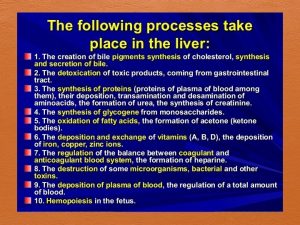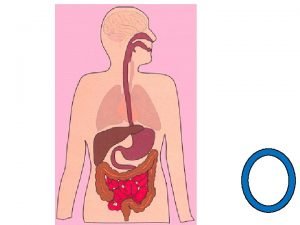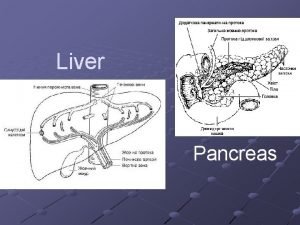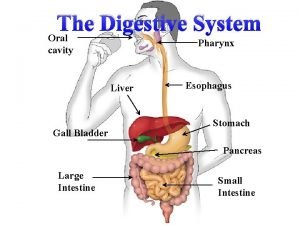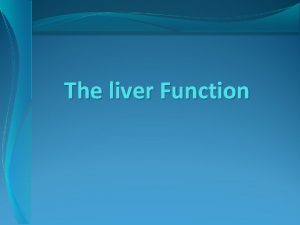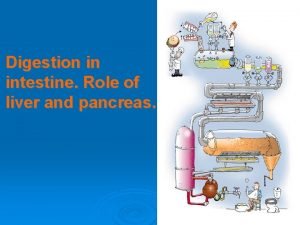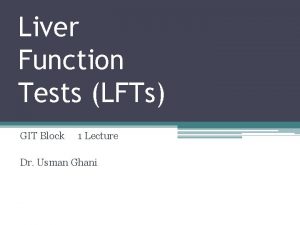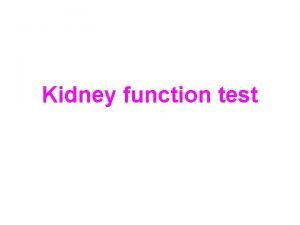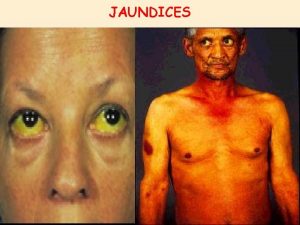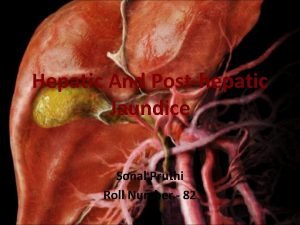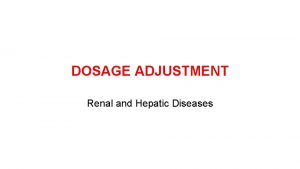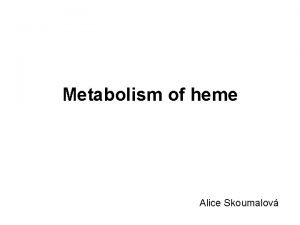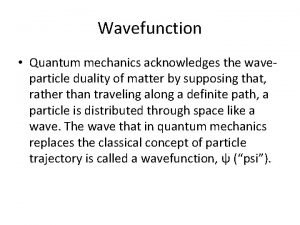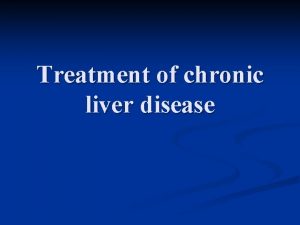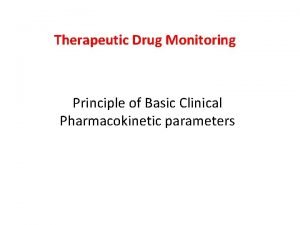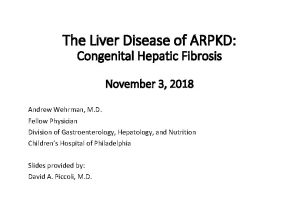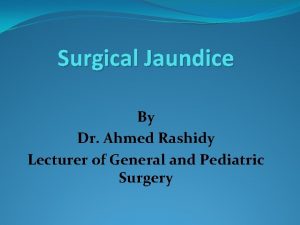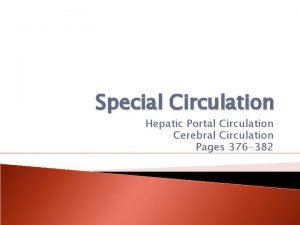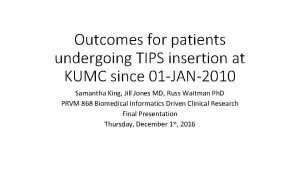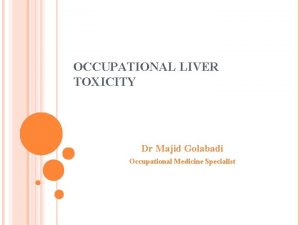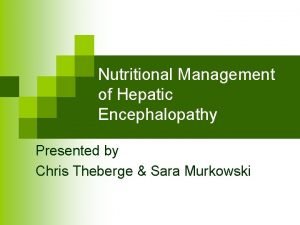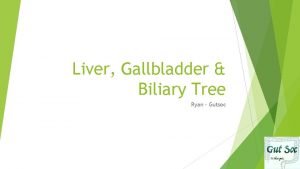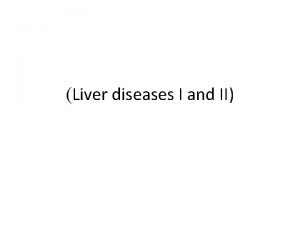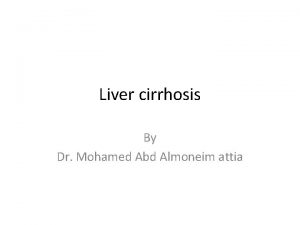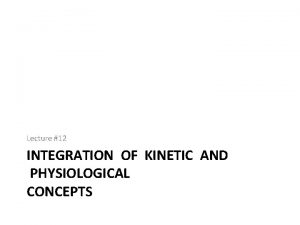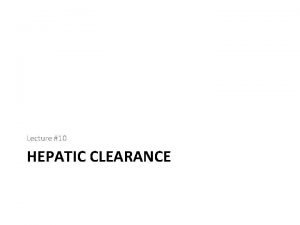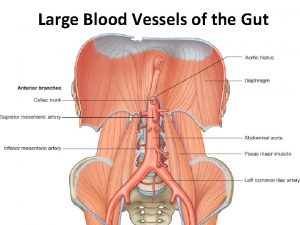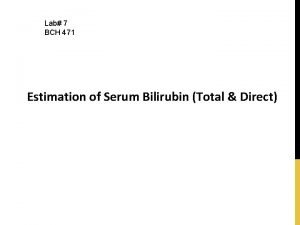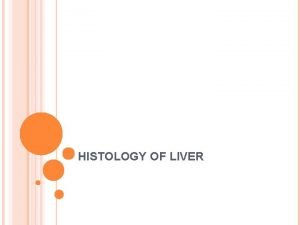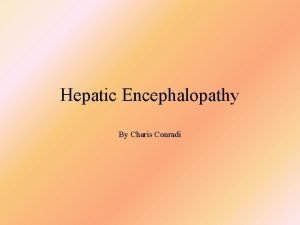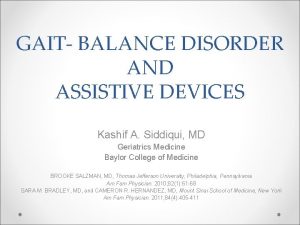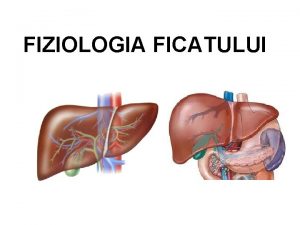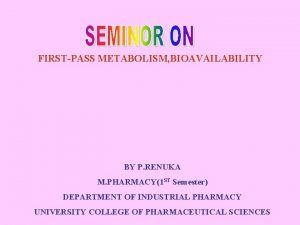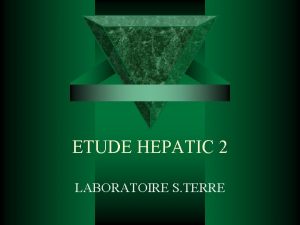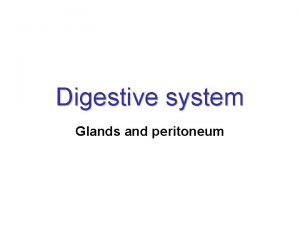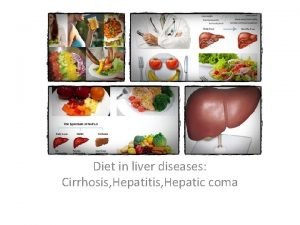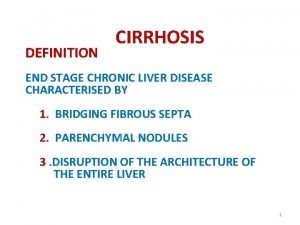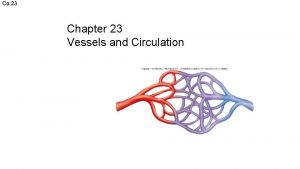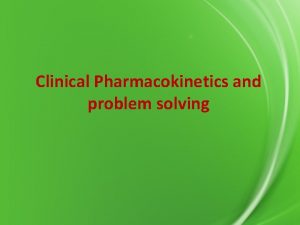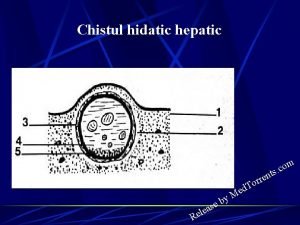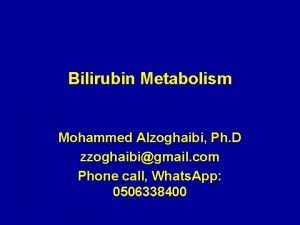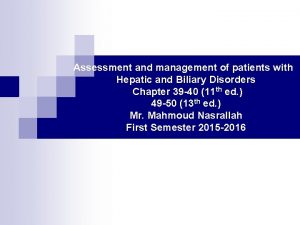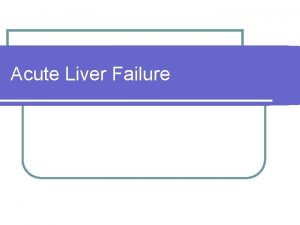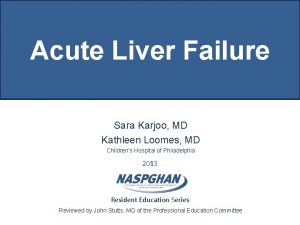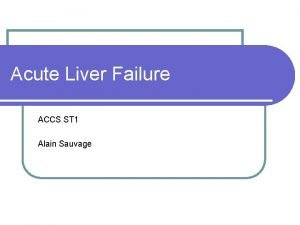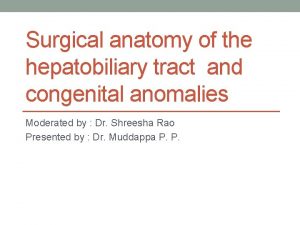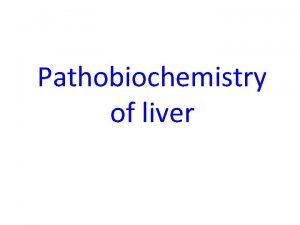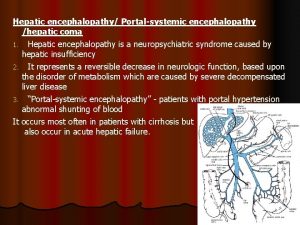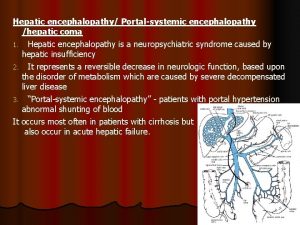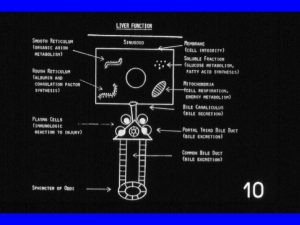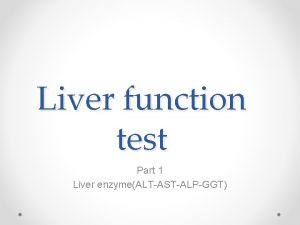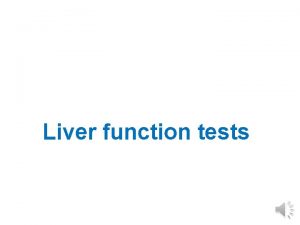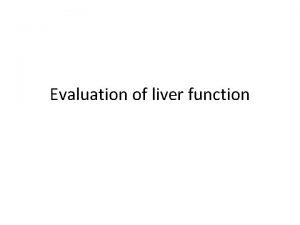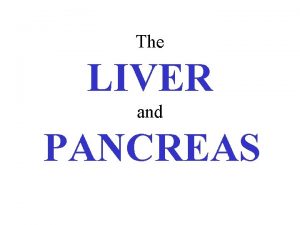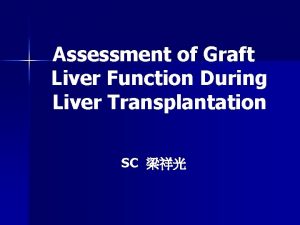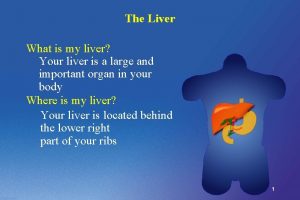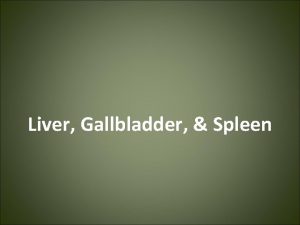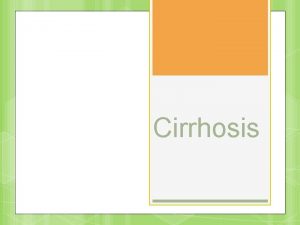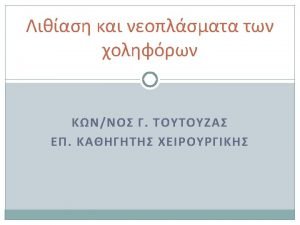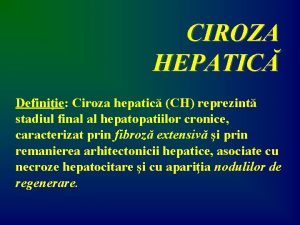Hepatic Physiology Assessment and interpretation of liver function




























































- Slides: 60

Hepatic Physiology & Assessment and interpretation of liver function tests Dr. M Sabra

• Liver is the largest internal organ & largest gland in the human body. • Liver is at the epicenter of intermediary metabolism , performs versatile & massive biochemical pathways and destroys bacteria, inactivate antigens, detoxify harmful chemicals. • Dual blood supply: Portal vein = 75% of HBF (55% of 02) , Hepatic artery = 25% of HBF (45% of 02) – Total hepatic blood flow = 25% of CO • Surgery and anesthesia impact hepatic function primarily due to their impact on hepatic blood flow and not primarily as a result of the medications or

Physiological functions of liver • Intermediary metabolism Carbohydrate metabolism Bile metabolsim • • Coagulation Heme metabolism Bilirubin metabolism Xenobiotics metabolism ( a foreign chemical • • Storage Endocrine functions Immune & inflammatory response Blood reservoir Lipid metabolism Protein metabolism substance found within an oraganism , not normally naturally produced by organism. Eg drugs antibiotics

Carbohydrate metabolism • Liver is an important homeostatic regulator of blood glucose. It can either produce glucose or store glucose • In fed state- polymerize glucose to glycogen • In unfed state- depolymerize glycogen to glucose • Glucose → hepatocytes → glycogen ↑ →glucose Lactate Glycerol aminoacids

Carbohydrate metabolism • Glycogen metabolism • Regulation – 2 rate limiting enzymes 1. Glycogen synthase- synthesis of glycogen from monomers of UDP glucose. 2. Glycogen phosphorylase- clevage of glycogen to glucose-1 -phosphate.

Carbohydrate metabolism Gluconeogenesis • Liver glycogen stores depleted - hepatic gluconeogenesis to replenish blood glucose. • Substrates- lactate - glycerol from hydrolysis of triglycerides - gluconeogenic amino acid , alanine , glutamine

Hormonal regulation of carbohydrate metabolism Glycogenolysis + + B. Glucose 6 PO 4 • Insulin + Glycogenesi s • Glucagon • Epinephrin e B. Glucose

• Blood glucose regulation within a narrow limit (70100 mg/dl) not affected in liver disease due to large reserve of hepatic function q Effects of anaesthesia on carbohydrate metabolism • Halothane – release of insulin – rate of glycogenolysis – Inhibition of gluconeogenic response • Isoflurane – Impaired insulin secretion

Lipid Metabolism • Oxidation of fatty acids • Fatty acids derived from plasma • Enter into mitochondria • oxidation: fatty acids Acetyl. Co. A citric acid cycle • Regulators - Glucagon - activates - Insulin - inhibits

• Synthesis of lipoproteins • One of the major functions of the liver • Major classes – VLDL (Very low density lipoproteins ) – LDL ( low density lipoproteins ) – HDL (High density lipoproteins)

• VLDL • Acute or chronic liver disease – ability to produce VLDL is markedly compromised • Liver VLDLs are associated with an important class of proteins, the apo B protein • Apo B 100 - important for hepatic secretion of VLDL. • Decreased in ABETALIPOPROTEINEMIA • LDLs and HDLs • Liver produces them in a small amount

• Production of ketone bodies • Most organs except the liver- use ketone bodies as fuel • Ketone bodies – acetoacetic acid, acetone, hydroxybutyrate • Their formation by the liver is normal and physiologically important, e. g. – Fasting rapid depletion of glycogen stores in the liver shortage of substrates for citric acid cycle – Acetyl. Co. A formed from oxidation ketone bodies • Ketosis - conc. of ketone bodies in blood – Starvation – DM – After high fat diet

• Synthesis of cholesterol • Important role in cholesterol homeostasis • Liver cholesterol has both exogenous and endogenous source Ø Uses of hepatic cholesterol • Formation of bile acids- conjugated with other substances to form cholic acid. • Synthesis of VLDLs

Bile metabolism & enterohepatic circulation • Bile salts are end products of cholesterol synthesis • Daily production – 600 - 800 ml/d • Functions- activate lipase - promote micelle formation - intestinal uptake of fat soluble vitamins, cholesterol & lipids - facilitate excretion of xenobiotics, lipophillic substances, bilirubin, amphipathic steroid hormone

• Bile salts undergo enterohepatic circulation (20 -30 times/day) intrahepatic bile duct ↓ common hepatic duct cystic duct ↓ gall bladder CBD ↓ small intestine ( terminal ileum) • Clinical implication – Opioids can induce spasm of bile duct & spinter of oddi – Reversed by – glucagon, opioid antagonists ( naloxone), smooth muscle relaxant (NTG),

Protein and amino acid metabolism • Deamination of amino acids – Required before they can be used for energy or before they can be converted into carbohydrates or fats • Formation of urea for removal of ammonia from the body fluids • Production of proteins and peptides.

Krebs- Hanseleit cycle Ø Major pathway for removing NH 3 & other nitrogenous wastes from body Ø Captures nitrogen in form of urea. Ø Failing liver- BUN remain low - ammonia accumulates in liver ↓ Hepatic encephalopathy

Proteins & peptides Albumin • Most abundant protein • Normal plasma conc- 3 - 5 g% • Daily production -12 -15 g/d • Plasma half life – 15 -20 days • Functions – • maintains plasma oncotic pressure (80% by albumin) • binds ions, bilirubin, hormones & drugs • Hypoalbuminemia – Colloid oncotic pressure edema

ᾳ- feto protein • Resembles albumin genetically & functionally • Formation sites- yolksac, hepatocytes, enterocytes • Fetal & neonatal life- major determinant of plasma oncotic pressure • 1 year of age- albumin largely replaces AFP • ↑ ↑ AFP- HCC

Fibrinogen • Synthesized exclusively by hepatocytes • Plasma fibrinogen – 100 -700 mg/dl • Functions – polymerizes into long fibrin threads by the action of thrombin formation of clot

• Haptoglobins – Forms stable complexes with free Hb prevents loss of iron through urinary excretion, protects kidney from damage • Ceruloplasmin – binds with copper and helps in its transport and storage • Wilson’s disease – Deficiency of ceruloplasmin free Cu 2+ in circulation deposited in brain and liver

Coagulation • Synthesize most of the procoagulants excepta. factor III ( tissue thromboplastin) b. Factor IV ( calcium) c. Factor VIII ( von Willebrand factor ) • Produce protein regulators of coagulation & fibrinolytic pathways – Protein C, protein S ( protein C – inactivate F VIIIa- Va complex) – – protein Z ( degradation of Factor Xa ) plasminogen activator inhibitor (PAI) ( inhibits tissue plasminogen activators to convert plasminogen to plasmin ) – antithrombin III

Liver as a Storage Organ • Vitamin A • Important role in the uptake, storage and maintenance of vitamin A levels by mobilizing its vitamin A store • Vitamin K dependent factors II, VII, IX, X • Absorption of Vit K depends on normal fat absorption: any mal-absorption of lipid vitamin K deficiency • Storage in liver- limited hypoprothrombinemia can develop within a few weeks. • Treatment – • FFP • Antidote- parenteral vit K

Vitamin K cofactor & ỳ- carboxylation – Factor II, VII. , IX, X , protein C & S- undergo Vit K dependent post translational modifications – Enables procoagulants to form complexes with calcium or other divalent cations for participation in the clotting cascade. q Clinical implication Warfarin inhibits vit K epoxide reductase ↓ traps Vit K in epoxide form ↓ Inhibits y- carboxylation Ø T/T- Enteral / parenteral Vit K.

Storage & Homeostasis of Iron • Major site of synthesis of proteins (Transferrin, Ferritin) involved in iron transport & metabolism. q Heme metabolism Clinical implication • Porphyrias • Acute Intermittent Porphyria – commonest – Defects in the heme pathway- accumulation of porphyrinogens – Trigger substances- barbiturates, sex hormones, glucocorticoides, cigarette smoke, CYP inducers.

Bilirubin Metabolism • Main source of bilirubin is heme metabolism • Daily production- 300 mg • 80 % derived from senescent erythrocytes by macrophages in RE system. • Heme ↓ ( heme oxygenase + o 2 ) biliverdin IX + CO + free divalent iron ↓ ( biliverdin reductase) bilirubin

Plasma Fragile RBCs BILIRUBIN METABOLISM RE System unconjugated bilirubin (protein – bound) Liver Urobilinogen Kidneys Liver Conjugated bilirubin Absorbed Bacterial action Urobilinogen Oxidation Urobilinogen Stercobilinogen Oxidation Stercobilin Intestinal Contents Urine

• • • CO produced has many physiological roles Vasodilation ( regulation of vascular tone) Platelet aggregation Vascular myocyte proliferation Neurotransmitter release Cytoprotective , antiapoptotic, antioxidant effects • Biliverdin – confers protection from oxidative effects • rapidly converts to bilirubin

Metabolism of Drugs (Xenobiotics) Factor affecting drug metabolism: microsomal enzyme system liver blood flow route of administration competitive inhibition Ø Phase-I reactions • Alter the parent drug by inserting or unmasking a polar group • Converts drugs to more polar compounds • Reactions – oxidations, reduction, hydrolysis • Cytochrome P 450 – substrate binding site, located in the endoplasmic reticulum • Drugs– barbiturates, benzodiazepines, halogenated volatile anaesthetics, pethidine etc.

• Phase-II reactions • Creates conjugates of parent compound or its metabolite with endogenous hydrophilic substrate Ø Reactions Glucoronidation Methylation Sulphation Acetylation q Glucoronidation • Most common type • Hepatic microsomal enzyme, UDPglucuronyl transferase mediates the transfer of glucoronic acid from UDP glucuronic acid to the functional group on the xenobiotics • Drug handled by phase-II – morphine, propofol, thiopentone (initially oxidized subsequently conjugated)

Ø Phase-I reaction enzymes – more susceptible to destruction in cirrhosis Ø Phase-II reactions enzymes – more resistant, function even in advanced liver disease q Phase-III reactions • Involves ATP-binding cassette transport proteins (ABC) • These proteins use the energy of ATP hydrolysis to drive molecular transport • Dysfunction of ABC proteins hinders flow of bile predisposing to drug accumulation and cholestatic liver injury

Microsomal enzyme induction • Anticonvulsants, rifampicin, isoniazid, glucocorticoids, chronic alcohol consumption Consequences of enzyme induction § duration of action of drugs that are inactivated by metabolism § intensity of action of drugs that are activated by metabolism

Endocrine functions • Liver can modify or amplify hormone action • Metabolic conversion of Vitamin D to form 25(OH)D • 25(OH)D 1, 25(OH)2 D in kidney • Peripheral conversion of T 4 to T 3 Ø Pseudocholinesterase • Hydrolysis of succinylcholine • Plasma t½ - 14 days • Severe liver disease duration of action of succinylcholine

• Insulin-like growth factors or somatomedins – growth hormone like action • Important role in cartilage function by promoting uptake of sulphate and synthesis of collagen Ø Removes circulating hormones • Insulin, glucagon, growth hormone, gastrointestinal hormones, e. g. gastrin

• Blood reservoir – Liver is an expandable organ – 10 -15 % of total blood volume can be sequestered and quickly released after sympathetic stimulation. • Immune & inflammatory responses – kuffer cells protect against foreign intrutions, degrade toxins, process antigens, and phagocytose bacteria. – Induce & intensify inflammation by recruiting neutrophils – Release proinflammatory mediators

Liver Function Tests • Uses • To detect the presence of liver disease • To distinguish among different type of liver disorders • To guage the extent of known liver damage • To follow the response to treatment • Shortcomings of LFTs Can be normal in pts with serious liver disease and abnormal in pts with diseases that do not affect the liver Only categorises into hepatocellular or cholestatic

• Classification of LFTs q Tests based on detoxification and excretory functions • Serum bilirubin • Breakdown product of porphyrin ring of heme containing proteins • 2 fractions - conjugated (direct – 30%) unconjugated (indirect – 70%) • Normal total serum bilirubin 1 mg/dl • in unconjugated fraction is rarely due to liver disease

Fractionate bilirubin >15% direct <15% direct Dubin Johnson syndr Rotor’s syndr Evaluation for hemolysis -ve +ve Crigler-Najjar syndr Gilbert’s syndr Hemolysis No further evaluation required

• Urine bilirubin • Any bilirubin found in urine is conjugated, therefore bilrubinuria implies presence of liver disease • Blood ammonia • Detection of encephalopathy, monitoring hepatic synthetic function • Very poor predictor: presence/ degree of acute encephalopathy • Serum enzymes • No known function in serum • ed level- rate of entrance into serum from damaged liver cells

• Enzymes categories • Enzymes that reflect damage to hepatocytes • Enzymes that reflect cholestasis • Enzymes that reflect damage to hepatocytes – Aminotransferases • Aspartate aminotransferase (AST or SGOT): Liver, cardiac muscle, skeletal muscle, kidneys, brain, pancreas, etc. • Alanine aminotransferase (ALT or SGPT): 1° in liver • Sensitive indicators of liver cell injury • Normal levels <35 -45 IU/L

• in aminotransferases • Mild - <250 IU/l – Any pathologic process that causes hepatocellular injury, e. g. hepatic steatosis, alcohol or drug induced liver disease, chronic viral hepatitis, cirrhosis, hemachromatosis • Moderate – 250 -1000 IU/l – Disorder that produces hepatocellular necrosis – e. g. Acute viral hepatitis, drug induced hepatitis, exacerbation of chronic hepatitis (alcoholic) • Large - >1000 IU/l – Viral or drug induced liver damage superimposed on ALD, autoimmune hepatitis

• Extreme - >2000 IU/l • Massive hepatic necrosis, usually from drugs (acetaminophan), halothane hepatitis, toxins, ischemic hepatitis (shock liver), acute viral hepatitis • AST/ALT ratio – DERITIS QUOTIENT – Normal - 1 or slightly > 1 • <1 – non-alcoholic steatosis or hepatitis without cirrhosis • 2 -4 – ALD • >4 – Wilsonian hepatitis AST/ ALT not ↑ in purely obstructive disorder except Acute biliary obstruction caused by passage of gallstones to CBD

• LDH § Normal level -25 -100 IU/L § Massive but transient - Ischemic hepatitis § Massive, sustained - Malignant infiltration of liver • Other causes of LDH • Hemolysis • Renal infarction • Acute stroke • Myocardial damage • Skeletal muscle injury

• Glutathione S transferase • Relatively sensitive and specific test for detecting druginduced hepatocellular injury • Plasma t½ 90 min, rapidly released into the circulation following hepatocellular injury • Plasma GST ( isoenzyme B ) – reveal time course of hepatocellular injury from onset to resolution • GST – located in the centrilobular region (zone 3), where hepatocytes are most susceptible to injuries from hypoxia and reactive drug metabolism

• Bromosulphathein excretion test • BSP dye- same mechanism as bilirubin -binding -conjugation -excretion § § BSP – i/v – 45 mins- levels in venous blood Normally- <5%. Slightly higher in old age Sensitive test to detect mild impairement of liver

Enzymes reflecting cholestasis • Alkaline phosphatase- present in cells of the bile duct § Isoenzymes- bone , liver, intestine, placenta , kidney , leukocytes. § Normal levels- 42 -122 IU/L - 3 -13 KA units/dl Non-pathological Age >60 yrs Bld group – O & B Growing children & adolescents Late in normal pregnancy Pathological 1° biliary cirrhosis Choledocholithiasis Hepatic malignancy 1° & 2° Paget’s disease

§ in serum ALP in an apparently healthy pt. § Fractionate the ALP to identify source of isoenzyme § ALP from different tissues differ in susceptibility inactivation by heat § Measure - 5' NT, GGT

• 5' NT • Sensitive and specific for hepatobiliary disorders (HBD) • Normal pregnancy, bone growth and bone diseases do not affect 5' NT • In pts with HBD, changes in ALP are usually followed by similar changes in 5' NT • GGT • Inducible microsomal enzyme. N levels – 5 - 40 IU/L. • Less specific than 5' NT as a marker for HBD • Unlike 5' NT, GGT may be released from many sites beside the hepatobiliary tree Ø Bone – important source of ALP, has little GGT thus GGT useful for differentiating hepatic & osseous sources of ALP

q Tests for bio-synthetic function of the liver • Estimation of plasma proteins • Tests for reversal of A: G ratio • Tests for coagulability of blood Plasma protein Total Normal levels 6. 4 – 8. 3 g% S. Albumin 3 – 5 g% Serum globulin 2 – 3 g% Serum fibrinogen 0. 3 g% Serum prothrombin 40 mg% A: G ratio 1. 7 : 1

• Serum albumin • S. albumin <3 g/dl suspect chronic liver disease • Hypoalbuminemia – not specific for liver disease – Protein malnutrition of any cause – Protein losing enteropathies – Nephrotic syndrome – Chronic infections – Burns • Reversal of A : G ratio chronic liver dysfunction.

• Serum globulin • in gamma globulin chronic liver disease • Ig M - ↑↑ Primary billiary cirrhosis. • Ig A – Alcoholic liver disease. • Ig G - ↑↑ Auto immune hepatitis. • Thymol turbidity test • Test for reversal of A: G ratio • Marked turbidity – liver insufficiency

• Coagulation factors § Factor I, II, V, VII § Short t 1/2 – single best measure of acute hepatic synthetic function § Tests –PT- N 11 -16 sec - PTTK – N 30 - 40 sec • Prognostic value§ PT > 5 sec above control – indicative of poor prognostic sign in acute viral hepatitis. § in hepatitis, cirrhosis, disorders leading to vit K deficiency such as obstructive jaundice or fat malabsorption

q Immunological tests • Antibodies to specific etiologic agents– – – • HBV- HBs. Ag , HBc. Ag, HBe. Ag Antibody to Entamoeba histolytica Antibody to CMV, HCV, EBV Non specific antibodies – – – Antimitochondrial antibody- PBC Antismooth muscle antibody- Auto immune hepatitis p. ANCA- Primary sclerosing cholangitis

• Serum tumor markers • feto-protein - ↑ in HCC. • Hepatobiliary imaging • USG, CT scan - 1 st line investigation • ERCP, PTC- visualization of biliary tract • Doppler USG& MRI- hepatic vasculature & heamodynamics • CT & MRI- hepatic masses & tumours

• Others • FNAC • Biopsy – percutaneous needle liver biopsy a) VIM –SILVERMAN ( cutting ) needle b) MENGHINI’S ( aspiration ) needle • Indications – – – Unexplained hepatomegaly Cholestasis of unknown cause Persistent abnormal LFTs Infiltrative disorders- sarcoidosis, tuberculosis Pyrexia of unknown origin Primary/ metastatic liver diseases

Blood tests & D/D of hepatic dysfunction Bilirubin overload Parenchymal (hemolysis) dysfunction cholestasis Aminotransferases Normal ↑ ( may be N or ↓ in N ( may be ↑in advanced stages) ALP Normal Increased serum bilirubin ↑ unconjugated ↑ conjugated Serum proteins Normal Decreased N (may be ↓ in advanced stages) Prothrombin time Normal ↓ (may be N in early stages) N (may be prolonged in advanced stages) Blood urea nitrogen Normal N (may be ↓ in advanced stages) Normal Retention Normal or retention Sulfobromophthalei Normal n / indocyanine green


Summary • Functions of liver I. synthetic Plasma protein (albumin) Hypoproteinimea → oedema Coagulants Haemorrhagic disorders Enzymes Hepatocellular disorders Urea / removal of NH 3 ↓ bld urea, ↑bld NH 3 II. Metabolic Carbohydrate ↓ glycogen – more damage ↓ bld. Glucose – muscle weakness, personality changes, tremors, slurred speech, convulsion, coma , death → pre hepatic coma Protein metabolism ↑ blood ammonia – aminoaciduria lipid metabolism Acc. Of FA in liver → fatty liver →pre hepatic hepatitis→ fibrosis→ cirrhosis→ ↑ portal pressure→ portal hypertension

III. Bile secretion Bile salts & acids steatorrhea Conjugation of bilirubin Hepatocellular jaundice IV. Miscellaneous Vit A, K Deficiency- ↓vit A , K Antibacterial action Prevent infections Destruction of RBCs Anemia , ↑ bilirubin

THANK YOU
 Function of liver physiology
Function of liver physiology Hepatic lobules of liver
Hepatic lobules of liver Liver hilus
Liver hilus Degluttination
Degluttination How does interpretation b differ from interpretation a
How does interpretation b differ from interpretation a Hepatic function panel
Hepatic function panel Liver and pancreas function
Liver and pancreas function Pharynx in digestive system
Pharynx in digestive system 5 functions of the liver
5 functions of the liver Synthetic function of liver
Synthetic function of liver Physiolocial
Physiolocial What is the primary function of the liver
What is the primary function of the liver When to worry about alt levels
When to worry about alt levels What is bilirubin
What is bilirubin Liver function test results explained uk
Liver function test results explained uk Intrahepatic jaundice
Intrahepatic jaundice Silent icterus
Silent icterus Loading dose formula
Loading dose formula Types of jaundice
Types of jaundice Schrodinger time dependent equation
Schrodinger time dependent equation Zoom simultaneous interpretation function
Zoom simultaneous interpretation function Hepatic encephalopathy pathophysiology
Hepatic encephalopathy pathophysiology Linear pharmacokinetics
Linear pharmacokinetics Hepatic facies
Hepatic facies Obstructive jaundice differential diagnosis
Obstructive jaundice differential diagnosis Hepatic portal vein.
Hepatic portal vein. Tips hepatic
Tips hepatic Hepatic toxicity
Hepatic toxicity Hepatic encephalopathy symptoms
Hepatic encephalopathy symptoms Bare area of liver
Bare area of liver Perisinusoidal space
Perisinusoidal space Mild hepatic steatosis
Mild hepatic steatosis Encephalopathy stages
Encephalopathy stages Hepatic extraction ratio formula
Hepatic extraction ratio formula Blood flow of liver
Blood flow of liver Superior rectal artery is a branch of
Superior rectal artery is a branch of Post hepatic jaundice
Post hepatic jaundice Loading dose calculation example
Loading dose calculation example Acinus liver
Acinus liver Hepatic encephalopathy treatment guidelines
Hepatic encephalopathy treatment guidelines Hepatic encephalopathy staging
Hepatic encephalopathy staging Hepatic encaph
Hepatic encaph Ficatul este situat
Ficatul este situat First pass metabolism definition pharmacology
First pass metabolism definition pharmacology Hepatic s terre posologie
Hepatic s terre posologie Facies visceralis hepatis
Facies visceralis hepatis Types of cirrhosis
Types of cirrhosis Hobnail fibrotic liver
Hobnail fibrotic liver Aorta branches
Aorta branches Hepatic extraction ratio formula
Hepatic extraction ratio formula Chist hidatic hepatic
Chist hidatic hepatic Figure 11-7 veins labeled
Figure 11-7 veins labeled Figure 11-14 is a diagram of a capillary bed
Figure 11-14 is a diagram of a capillary bed Post hepatic jaundice
Post hepatic jaundice Choledochlithotomy
Choledochlithotomy Fhf
Fhf Hepatic encephalopathy stages
Hepatic encephalopathy stages S.terre hepatic
S.terre hepatic Hepatic encephalopathy staging
Hepatic encephalopathy staging Calot's triangle boundaries
Calot's triangle boundaries Mkmol
Mkmol
